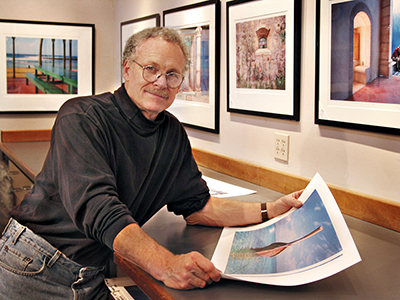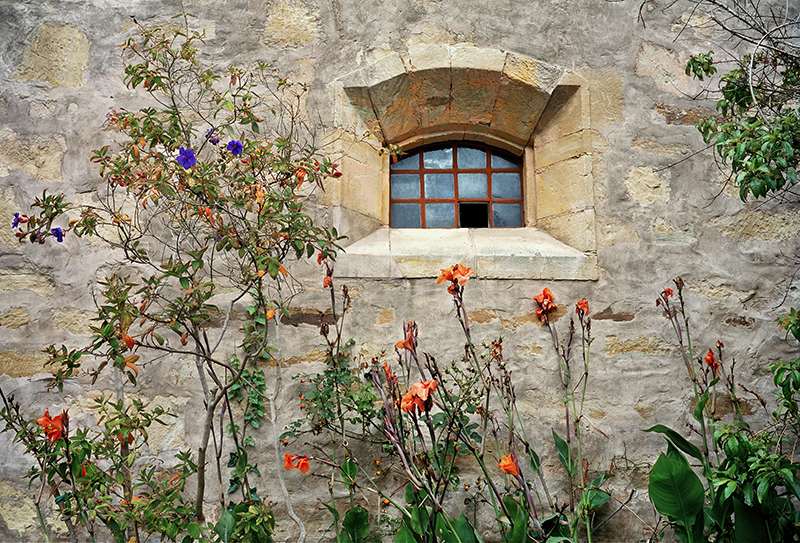Junipero's Garden
In keeping with our 2019/20 Season theme of “old meets new” we are thrilled to share the work of some of Canada’s and the world’s most exciting contemporary artists as part of our season campaign.
These stunning images were chosen to complement both the season theme and the theme of each individual concert. We chatted with Steve Solinsky, the photographer behind the image for Baroque Roots.
Tafelmusik: Tell us a little about yourself, and how you started in your field of art?

This was the captivating spark that lit my creative fire. What followed were years of taking slides with a little 35mm, mostly on hiking and camping trips.
About this time the Sierra Club started publishing their photography books celebrating the wild in its many forms, and I quickly became a fan. In the 70s I constructed a rudimentary darkroom. There I made my first prints in black and white, and eventually with some courage I tried colour printing — making prints in a drum. While I loved the power of B&W, I found colour for me to be most compelling. What followed was a stint as a graphic designer, which led to a contract for me to produce framed wall art for one of my clients, a hotel-chain. This began my extensive experience as a colour print maker, as I identify myself now. Ansel Adams lyrically described the negative as the score, and the print as the performance. Of course, both require true mastery for works that enchant.
TM: Tell us more about the artwork featured in our season campaign and your concept behind it. What was your process while creating it?
SS: Junipero’s Garden was shot in passing, of one of the walls at Carmel Mission, CA. What caught my eye was the textural counterpoint of adobe and stone and the wavy faceted glass reflecting clouds from an overcast day.
And then there’s the one pane of missing glass. Little details like this add a visual intrigue to the composition — something unexpected, but somehow a perfect accent. I generally love reflections which tend to break matter’s opaque spell, opening my perception to a deeper symbolic suggestion that “there’s more to this than what’s on the surface- perhaps, a richer, more luminous world.” Of course, at the same time, as graphic designer I look for a richness of harmony, of colour and form. I never go out with agendas or ideas of what to look for, but allow serendipity to be my guide. I’ve traveled so many roads, so many alleyways without a map — I actually prefer to be lost. I’m working now on a retrospective book project which I gave this working title: “Nowhere in Particular”. It’s a play of words, and like all images or art, it has its magic depending on how you reflect it. The title simply describes my approach to imagery — to not worry about subjects or locations- to release all agendas, no grand rules or fancy philosophy to follow, just an openness and readiness to be caught in fascination's net. That is where the magic lies, beyond anything I might dream up. Then Nowhere can become Now Here! Images like these have the potential to be creative, alive, and never to loose their power to intrigue, even after many years or viewings. I think this is the crux of all great art – and the emergent creative power of Universe, and Life to run circles around the mind. But hey, out of this wakeful swirling dance with the world, joy fills my being, and the deep gratitude for witnessing another day. Hallelujah!
TM: Tafelmusik’s 2019/20 season theme is “Old Meets New.” How do you feel your art fits with this theme?
SS: The stone adobe wall depicted in Junipero’s Garden was built by the early Spanish missionaries with the help of local Indians, and dates from the late 1700’s which qualifies as old in US terms. Aside from the official history, the materials belie the fact—the rough—hewn adobe, and stone, with the European formal influence of the window frame… and the smoky wavy glass. There’s a rhythm to the flowers — the matrix of glass suggesting the order of a stave, and the scale of dancing flowers, such sweet notes. The one dark pane awaits a viewer to enter the image to consummate the dream. Art depends on an observer to complete the creative circle.
I experience a deep satisfaction when I create my work, because it speaks to my soul. Why else would I take it up? I love these images, and experience a wonderful feeling of centeredness and beauty when I take them in. It’s not to suggest they’re anything special, but just that they’ve been born from a loving heart.
I also enjoy music, and when I find myself enchanted by a performance, it’s a very familiar feeling to my art- an opening of the heart, a stirring of inspirational movement; both share the flavor of wonder and the creative soul.
I suspect that this is not unusual. Many great photographers I know of are also accomplished musicians. There appears to be a common hidden thread.
Artists, both visual and aural, invite others on brief perceptual journeys through works of their loving and awakened being.
TM: What is your favourite music to listen to when making art? Doesn’t have to be classical!
SS: My taste in music is wide, and includes many genres, but most recently I seem mainly captivated by beautiful vocals — usually female. My favourite is a product of Canada — Celine Dion. There’s something about the human voice that carries so much heart, and Celine has such a magnificent command of her vocals — so smooth, so rich, so sensual.
What’s over the top for me, though, is when beautiful female and male voices mix in harmony. That’s heaven. The experience of music like this is actually similar to what I feel when I’m experiencing a masterful image. I don’t know, it may be the same experience with each genre — heart in unity with all beings, in a celebration of soul.
Beyond that, there are too many other examples I can think of to cite.
TM: What shows or exhibitions are you dying to see? Is there an artist or organization you’d encourage our followers to explore?
SS: In the art arena, over the years, I’ve been influenced by many great artists, some photographers and some painters.
In 1988, I viewed an exhibit of Andrew Wyeth’s originals and was dumbstruck by their power and beauty. Aside from an amazing command of his medium, he had extraordinary vision. His works exude feeling — sometimes ominous, sometimes brilliant in his sense of light and life- and always wonderfully enchanting. For budding artists, I recommend studying Wyeth’s work, or any works, or artists that are deeply moving, and ask this question- what does this work evoke in me? What’s it’s magic? The answer may not be immediate or clear, but the question’s important — an invitation, less about what I see out there, and more about cultivating curiosity and gratitude for my own heart-felt response. This is the womb of all great works.
Speaking of colour photographers, some who’ve influenced me are Elliot Porter, early on, followed by Ernst Hass, and eventually, Joel Meyerowitz. His Cape Light book was a revelation to me — he demonstrates that it’s not the inherent subject you capture, but how you see it, which often owes its magic to the light. It’s a testament to the moment, and the fact any subject can evoke awe — it’s the coming together of conditions (object and light), the non-judgmental witness, and an equal attention to whatever’s evoked within. Many of his images are so achingly beautiful, despite the subject’s ordinariness — like a gas pump. He taught me to look with an unbiased eye at everything, and then I may come to SEE.
There are too many other wonderful photographers to mention here. But one thing they all share is authentic personal vision.
TM: What’s the best piece of advice you’ve been given?
SS: You’ve probably gathered by now that I’ve had wonderful and profound influences. But, my journey as an artist has been a singular one — the inner path of the soul .
Perhaps the best instruction I have received is from my Buddhist practice, which if you’re familiar, is not anything about dogma, or advice in the ordinary sense. It is a training of the mind — instruction of how not to be caught by outside conditions which can captivate and clutter the mind, undermining one’s ability to create a calm meaningful life, and to be happy.
The practice is a path to freedom, to freeing the mind from patterns of suffering, but, thankfully, it also helps to clarify one’s powers of perception, which is essential for me, the artist.
The Buddha can be summarized as saying, “Don’t believe what I say, just engage the practice, and see for yourself”.
And, this is all I can do, and have done as an artist.
See more of Steve's work at solinskyphoto.com.
Join us for Baroque Roots from October 16–20, 2019 at Jeanne Lamon Hall, Trinity-St. Paul's Centre. BUY TICKETS

